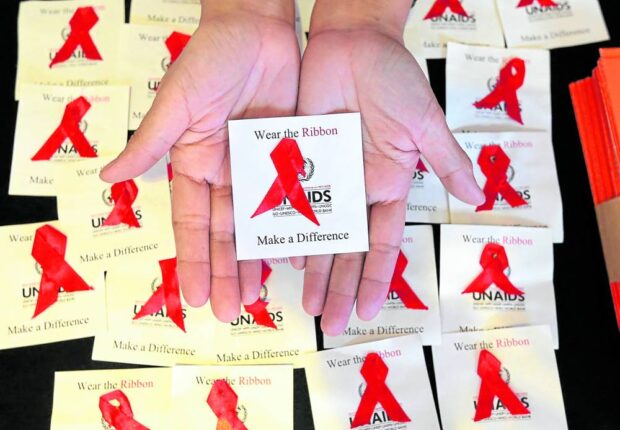DOH alerted to ‘unstable’ supply of HIV drugs since May

RED ALERT | Network Plus Philippines sounds the alarm on the “unstable supply” of drugs for the human immunodeficiency virus (HIV) in four regions outside Metro Manila. In this photo, a woman campaigns for awareness on acquired immunodeficiency syndrome (AIDS), the most severe stage of HIV infection. (Photo by MARIANNE BERMUDEZ / Philippine Daily Inquirer)
MANILA, Philippines — People living with the human immunodeficiency virus (PLHIV) in four regions outside Metro Manila are facing a “life-and-death situation” due to a dwindling supply of HIV medications, according to an advocacy group.
In an advisory on Tuesday, Network Plus Philippines pressed the Department of Health (DOH) and the Philippine National AIDS Council (PNAC) for a “concrete response” after some PLHIV complained of receiving only “one bottle or less” of antiretroviral (ARV) drugs from HIV treatment facilities in Cagayan Valley, Central Luzon, Bicol and Central Visayas.
“The Network Plus Philippines demand [DOH and PNAC] to address the issue with immediate and long-term solutions, hold themselves accountable … and not [be] remiss [in] their duties to ensure that PLHIV are given equitable access to quality ARV treatment,” it said.
The presence of HIV in the body can be managed through antiretroviral therapy (ART), a regimen of prescribed maintenance medication widely used among people with HIV.
Left untreated, it can lead to its most severe stage—acquired immunodeficiency syndrome (AIDS), which is life-threatening.
Supply realignments
Network Plus said concerns over the “unstable” supply of HIV medicines started on May 25, “and up to this date, the PLHIV community continued reporting related issues about their ARV refills.”
Some patients were even asked to “prepare to buy their own medication,” the group said.
Upon raising the issue with the DOH, the group said the health department responded on May 31, confirming a “low stock level” in those regions, while noting it has “facilitated realignments” for June.
Deliveries for tenofovir/lamivudine/dolutegravir (TLD) regimen, a type of ARV considered the gold standard in HIV treatment, are also expected to arrive between the end of June and early July, the DOH told the group.
According to Elena Felix, one of the convenors of Network Plus, a PLHIV who visits a treatment hub to get a refill of HIV medicines usually gets at least three bottles.
A bottle of ARV is equivalent to a month’s supply of pills to be taken daily.
But based on recent complaints, including on social media, a number of patients reported receiving only seven to 10 pills—a far cry from the usual 30.
“What if I get only 10 pills, does this mean I have to go to the facility every 10 days? … What if I live far from the treatment hub?” Felix told the Inquirer by phone.
“This will also affect their mental health because of the worry of whether stocks will arrive, or until when this will go on,” she said. “They might also fear that they won’t be able to take their medicine for days.”
“This is [a] life-and-death situation for them,” Felix said.
HIV medicines are available for free at treatment hubs, which include provincial and local government hospitals, primary health-care centers and social hygiene clinics. But with a dearth in supply, patients will have to pay out of their pockets.
P1,000 a bottle
An average cost of one bottle of ARV is about P1,000, a huge burden to most PLHIV who are unemployed, including teenagers, Felix said.
“The national PLHIV community has been demanding long-term solutions since we first experienced problems of ARV stock-outs in 2014,” Network Plus said in its notice.
Last year, treatment facilities also experienced a shortage of HIV drugs, Felix pointed out.
“Yet, we see only stop-gap solutions like redistribution of stocks … we can no longer settle for intermediary reactive measures,” the group said.
The Inquirer sought the DOH’s comment but did not receive a reply at press time.
Earlier this month, Health Secretary Teodoro Herbosa vowed to prioritize HIV prevention and treatment, saying that was one of the President’s orders.
Based on the latest DOH registry, about 1,000 people were enrolled to ARV therapy in April, 994 of whom were on “first line” regimen. More than half of them, or 512 individuals, were 25 years old to 34 years old.
The data showed that 1,240 people were confirmed to have HIV in April, or an average of 50 people diagnosed with HIV per day. Those who died from AIDS since January have reached 101.
The country’s total HIV tally is now at 115,248 since it began tracking HIV cases in 1984. Of the new cases, 335 were at an “advanced” HIV infection.